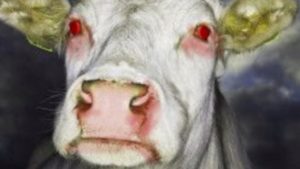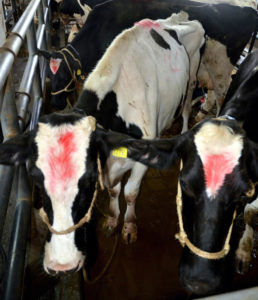Mad Cow Disease (Spongiform Encephalopathy or BSE)
Mad cow disease, or bovine spongiform encephalopathy (BSE), is a disease that was first found in cattle. It’s related to a disease in humans called variant Creutzfeldt-Jakob disease (vCJD). Both disorders are universally fatal brain diseases caused by a prion. A prion is a protein particle that lacks DNA (nucleic acid). It’s believed to be the cause of various infectious diseases of the nervous system. Eating infected cattle products, including beef, can cause a human to develop mad cow disease.
What is mad cow disease?
Mad cow disease is a progressive, fatal neurological disorder of cattle resulting from infection by a prion. It appears to be caused by contaminated cattle feed that contains the prion agent. Most mad cow disease has happened in cattle in the United Kingdom (U.K.), a few cases were found in cattle in the U.S. between 2003 and 2006. There were 4 more reported up to 2018. Feed regulations were then tightened.
In addition to the cases of mad cow reported in the U.K. (78% of all cases were reported there) and the U.S., cases have also been reported in other countries, including France, Spain, Netherlands, Portugal, Ireland, Italy, Japan, Saudi Arabia, and Canada. Public health control measures have been implemented in many of the countries to prevent potentially infected tissues from entering the human food chain. These preventative measures appear to have been effective. For instance, Canada believes its prevention measures will wipe out the disease from its cattle population by 2017.
What is variant Creutzfeldt-Jakob Disease (vCJD)?
Creutzfeldt-Jakob Disease (CJD) is a rare, fatal brain disorder. It causes a rapid, progressive dementia (deterioration of mental functions), as well as associated neuromuscular disturbances. The disease, which in some ways resembles mad cow disease, traditionally has affected men and women between the ages of 50 and 75. The variant form, however, affects younger people (the average age of onset is 28) and has observed features that are not typical as compared with CJD. About 230 people with vCJD have been identified since 1996. Most are from the U.K. and other countries in Europe. It is rare in the U.S., with only 4 reported cases since 1996 until May of 2023 in Chicago found in baby cow.
What is the current risk of acquiring vCJD from eating beef and beef products produced from cattle in Europe?
Currently this risk appears to be very small, perhaps fewer than 1 case per 10 billion servings–if the risk exists at all. Travelers to Europe who are concerned about reducing any risk of exposure can avoid beef and beef products altogether, or can select beef or beef products, such as solid pieces of muscle meat, as opposed to ground beef and sausages. Solid pieces of beef are less likely to be contaminated with tissues that may hide the mad cow agent. Milk and milk products are not believed to transmit the mad cow agent. You can’t get vCJD or CJD by direct contact with a person who has the disease. Three cases acquired during transfusion of blood from an infected donor have been reported in the U.K. Most human Creutzfeldt-Jakob disease is not vCJD and is not related to beef consumption but is also likely due to prion proteins
The Risk of getting Mad Cow Disease in the US, based on CDC-Centers for Disease Prevention and Control show the following statistics:
On December 23, 2003, the U.S. Department of Agriculture (USDA) announced a presumptive diagnosis of the first known case of BSE in the United States. It was in an adult Holstein cow from Washington State. This diagnosis was confirmed by an international reference laboratory in Weybridge, England, on December 25. Trace-back based on an ear-tag identification number and subsequent genetic testing confirmed that the BSE-infected cow was imported into the United States from Canada in August 2001.
Because the animal was non-ambulatory (a “downer cow”) at slaughter, brain tissue samples were taken by USDA’s Animal and Plant Health Inspection Service as part of its targeted surveillance for BSE. However the animal’s condition was attributed to complications from calving. After the animal was examined by a USDA Food Safety and Inspection Service (FSIS) veterinary medical officer both before and after slaughter, the carcass was released for use as food for human consumption. During slaughter, the tissues considered to be at high risk for the transmission of the BSE agent were removed.
On December 24, 2003, FSIS recalled beef from cattle slaughtered in the same plant on the same day as the BSE positive cow.
On June 24, 2005, the USDA announced receipt of final results from The Veterinary Laboratories Agency in Weybridge, England, confirming BSE in a cow that had conflicting test results in 2004. This cow was from Texas, died at approximately 12 years of age, and represented the first endemic case of BSE by a cow in the United States.
On March 15, 2006, the USDA announced the confirmation of BSE in a cow in Alabama. The case was identified in a non-ambulatory (downer) cow on a farm in Alabama. The animal was euthanized by a local veterinarian and buried on the farm. The age of the cow was estimated by examination of the dentition as 10 years old.
It had no ear tags or distinctive marks; the herd of origin could not be identified despite an intense investigation.
In August 2008, several ARS investigators reported that a rare, genetic abnormality that may persist within the cattle population “is considered to have caused” BSE in this atypical (H-type) BSE animal from Alabama.
On April 24, 2012, the USDA confirmed a BSE case in a dairy cow in California. This cow was tested as part of the USDA targeted BSE surveillance at rendering facilities in the United States. The cow was 10 years and 7 months old and was classified as having the L-type BSE strain.
On July 18, 2017, the U.S. Department of Agriculture (USDA) announced the confirmation of the fifth case of bovine spongiform encephalopathy (BSE) in an 11-year-old cow in Alabama. The cow was found through USDA’s routine surveillance. The cow was found to be positive for an atypical (L-type) strain of BSE. Atypical BSE usually occurs in older cattle and seems to arise spontaneously in cattle populations.
On August 29, 2018 the U.S. Department of Agriculture (USDA) announced a confirmed atypical, H-type case of bovine spongiform encephalopathy (BSE) in a six year old mixed-breed beef cow in Florida. USDA reported that this animal never entered the food supply and at no time presented a risk to human health.
How does the cow even get Mad Cow Disease?
The parts of a cow that are not eaten by people are cooked, dried, and ground into a powder. The powder is then used for a variety of purposes, including as an ingredient in animal feed. A cow gets BSE by eating feed contaminated with parts that came from another cow that was sick with BSE. The contaminated feed contains the abnormal prion, and a cow becomes infected with the abnormal prion when it eats the feed. If a cow gets BSE, it most likely ate the contaminated feed during its first year of life. Remember, if a cow becomes infected with the abnormal prion when it is one-year-old, it usually will not show signs of BSE until it is five-years-old or possibly older.
Learn more tomorrow in Part II on Mad Cow Disease.

